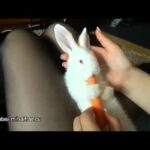Our first tale is of a baby pygmy cottontail rabbit arrived from Santa Clara, Utah. It was brought to us in a small box with blood on its nose and appeared to be in shock. The rescuer said two cats had it cornered and he wasn’t sure if it was hurt.
Susan observed that most likely the baby had left the nest and appeared to be about 3 weeks old and at this point formula was no longer needed and could cause harm. With their delicate digestive system and the stress of handling, it was better to not force anything but to leave it quiet with food available.
We placed the baby rabbit with a small hiding box into one of our small fabric puppy playpens. We left it with fresh alfalfa and native grasses in its quiet darkened safe place where we just continued to add fresh food for the first week. Water was also made available, however wild rabbits get most of their water from the plants they eat or from morning dew on the plants.
The second week it stayed in a slightly larger cage where we continued to provide natural grasses and alfalfa until its release back to the wild. We relocated it to an area with other pygmy cottontail rabbits where cover and food was abundant.
Our next tale is of a young Cooper’s hawk that had fledged and left its nest. The parents have begun their migration, leaving their young to figure out how to find food on their own.
We frequently have coopers hawks hunt pigeons in our yard as they migrate through our area. This is common as they follow flocks of small birds which is their primary diet and are occasionally seen speeding through backyards snatching small birds attracted to backyard feeders.
While sitting in the front yard one evening, Susan was with Martin as he was holding and manning Belle. Martin pointed out the young coopers hawk and young pigeon to Susan as they moved around on top of our pigeon coop. After watching them for several minutes Susan began to video as it was very apparent that the pigeon and the hawk were both unsure how to handle the situation.
The pigeon was lucky this time as the hawk hadn’t learned yet how to catch something so large, but when the hawk gains experience, next time the pigeon might not be so lucky.
Other tales in this video include the care, feeding and release of many house finches, a Wren and a Kingbird.
Please Visit:
Please Help:
Rodent Pro Gift Certificates:
Martin’s Book:
Please Shop our Amazon Wishlist:
Please support us through Amazon Smile:
_Mail Donations_
You are welcome to mail us a donation or call to ask any questions about our organization.
Phone: (435) 586-4693 • (435) 590-1618
Address: P.O. Box 1907
Cedar City, UT 84721-1907
Checks Payable to: Southwest Wildlife Foundation of Utah
Official Site:
YouTube:
Facebook:
Twitter:
Instagram:
Web hosting generously provided by:
_Our Mission_
Founded in 1997 in Cedar City Utah, we are a 501c3 non-profit organization dedicated to wildlife rescue and rehabilitation, wildlife and environmental education, and the development of the Cedar Canyon Nature Park.
_Rescue, Rehabilitate and Release_
The Southwest Wildlife Foundation of Utah (SWF) cares for more than 100 sick, injured and orphaned native wildlife annually. Restoring them to health and returning them to the wild is our primary goal, but for those that cannot be released due to disabilities, the Cedar Canyon Nature Park (CCNP) can provide them with a permanent home in a natural setting while enhancing our visitors educational experience at the park.
_Informing, Educating and Inspiring_
The SWF provides over 100 educational programs reaching over 30,000 people annually. We believe providing educational outreach programs to schools, scout groups and community events, with focus on children and families, will make the greatest impact in preserving our wildlife, the environment, our public lands and our resources for future generations to enjoy.
_Martin Tyner_
Since age twelve, with a bird on his arm, Martin has captivated audiences sharing his knowledge and experience of his wildlife friends.
At age nineteen, Martin was hired as curator of birds of prey at Busch Gardens, CA. He also worked in the movie and television industry training big cats, elephants, primates, sea mammals and raptors.
Martin Tyner is a federally licensed falconer, eagle falconer, wildlife rehabilitator, wildlife propagator, and wildlife and environmental educator.








